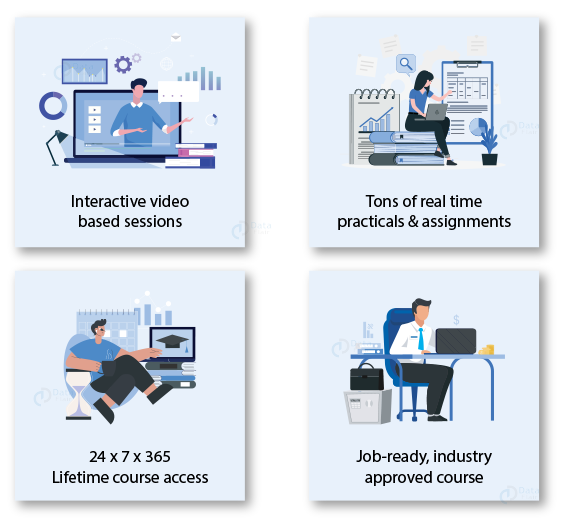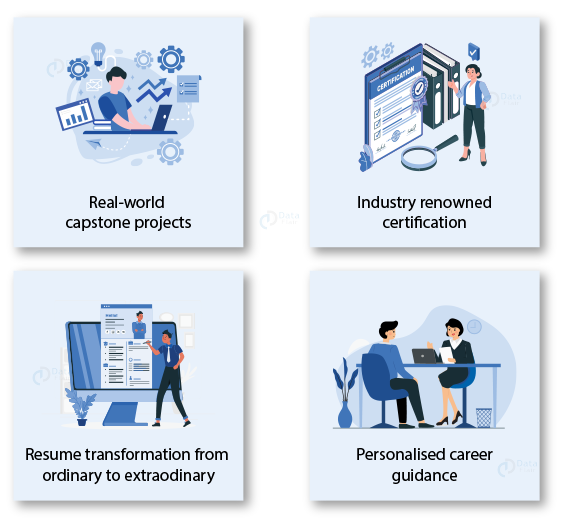Free CSS Course with Certificate [Hindi]
 Cascading Style Sheets, or CSS, is the design language used on the internet. It’s sorcery that turns unadorned HTML files into aesthetically pleasing and engaging web pages. Making your web content both useful and aesthetically beautiful is easy with CSS, which lets you manage everything from colors and fonts to layout and animations.
Cascading Style Sheets, or CSS, is the design language used on the internet. It’s sorcery that turns unadorned HTML files into aesthetically pleasing and engaging web pages. Making your web content both useful and aesthetically beautiful is easy with CSS, which lets you manage everything from colors and fonts to layout and animations.
What will you take home from this Free CSS Course?
- Self-paced video course
- 170+ hrs of study material, practicals, quizzes
- Acquire practical knowledge which industry needs
- Practical CSS course with real-time case-studies
- Lifetime access with industry renowned certification
Why should you enroll in this Free CSS course?
- Selectors, properties, and responsive design are all topics you’ll learn about as you progress through the CSS curriculum
- To hone your abilities, practice with exercises and real-world assignments
- Keep abreast with the newest CSS features and recommended techniques
- To demonstrate your abilities, get a completion certificate
- Recognize the value of responsive design
- For effective development, look into well-known CSS frameworks like Foundation and Bootstrap
- Gain knowledge about the basics of web programming
- Enhance the potential of your web design or development profession
- Make websites that are both aesthetically pleasing and easy to use
- Develop your online content styling skills with confidence
- Professionals with real-world experience in the sector can teach you
- Take use of resources and a helpful learning community
- Discover how to make sure that all popular browsers display your designs beautifully
- Increase the opportunities for freelancing work
- Develop the skill of developing websites that fluidly adjust to various screen sizes with responsive web design
- Keep up with the tech industry’s constant change
- Become well-versed in the fundamentals of web development before mastering more complex ones
- Design is a good way to get creative with web development
- You should have control over the aesthetics of your web projects
- CSS challenges will help you develop your problem-solving skills
CSS Course Objectives
The Cascading Style Sheets (CSS) course provides a thorough and practical introduction to the field. This CSS course is made to give you the abilities and information required to produce aesthetically pleasing and responsive web designs, regardless of whether you’re a complete beginner or have some past understanding of web development. As you proceed, you’ll study more sophisticated concepts like layout and placement, typography, animations, and CSS frameworks.
You’ll start by learning the fundamentals of CSS syntax, selectors, and properties. Throughout this CSS course, you’ll have the chance to put what you’ve learned into practice through practical projects, ensuring that you’re able to successfully style web content and address typical design issues. You will explore the artistic and technical facets of web design, our knowledgeable educators are committed to creating a helpful learning environment.
They will offer advice and support. You’ll have a solid foundation in CSS at the end of this CSS course, allowing you to advance your web development skills whether you’re hoping to pursue a profession in web design or are just trying to improve the aesthetics and usability of your website. Come along on the ride as we explore the potential of CSS to turn your web projects into pieces of art.
Learning the essentials of CSS, including how to choose HTML components, use styles, and manage layout, will be the first step for participants. As they continue, they will cover more complex subjects including responsive web design, animations, and the use of CSS frameworks, giving them a comprehensive knowledge of CSS.
Through practical exercises and in-depth projects, this CSS course places a strong emphasis on practical learning. Participants will have the chance to put CSS concepts to practice when building websites, designing user interfaces, and resolving typical web styling issues. Their confidence and ability to use CSS efficiently will increase as a result of this hands-on training.
Participants will develop their skills in responsive web design so that the websites they build may easily adapt to different screen sizes and devices. In the multi-device environment of today, this ability is essential. In conclusion, the goal of the CSS course is to give students a solid foundation in the language, hands-on experience, and the self-assurance to use what they have learned to build attractive, functional websites.
Why should you learn CSS?
CSS promises immense promises in the IT industry. The demand of a CSS-skilled user is huge and therefore learning CSS from DataFlair’s course can prove extremely fruitful. Here are some facts to prove that-
- “CSS is the web design language. It is the instrument that makes your original ideas come to life online.” -Not known
- “75% of web users admit evaluating a company’s credibility based on the layout of their website.” -Persuasive Technology Lab at Stanford
- As the saying goes, “Web development without CSS is like building a house without paint; it lacks the finishing touch.” -Christopher Spooner
- Front-end engineers that are proficient in CSS make, on average, 20% more than their contemporaries -CSS Techniques
- “For web developers, CSS is a superpower. You can use it to transform code into artwork.” -David Rupert
What is CSS?
Cascading Style Sheets, or CSS, is a key web development technology that is essential in determining how web pages look and are organized. It is a language for creating style sheets that specify how HTML (Hypertext Markup Language) elements should appear in a web browser. CSS, which stands for Cascading Style Sheets, is what gives web content its design, including the fonts, colors, spacing, element placement, and overall aesthetic appeal.
CSS’s primary mode of operation is the application of rules, often known as styles, to HTML components. These guidelines specify how items should be displayed, giving web developers and designers complete freedom over the visual presentation of a web page. Website maintenance and updating are made simpler by CASs crisp separation of display and content (HTML). Web designers may develop aesthetically appealing and responsive designs with CSS that automatically adjust to various screen sizes and devices.
The most recent standards, such CSS3, add sophisticated capabilities like animations, transitions, and 3D effects, pushing the limits of what is possible in web design. CSS is a developing technology. Anyone working in web development, from front-end designers and developers who create user interfaces to full-stack engineers who must comprehend both client-side and server-side technologies, needs to be proficient in CSS. In the end, CSS enables site designers to translate their ideas into alluring and approachable online experiences.
What to do before you begin?
Prerequisites to this course are non-mandatory since DataFlair provides each and every asset that you would require. Since CSS is used to style HTML texts, it’s beneficial to have a foundational knowledge of HTML before beginning this CSS course.
- If you’re new to web development, you might want to enroll in an introductory HTML course to have a better understanding of how web pages are put together.
- A little understanding of JavaScript might also be helpful because it enables you to build dynamic online experiences.
- Make sure you have a code editor installed on your computer before beginning this course, such as Visual Studio Code or Sublime Text. You will use these tools as your workstation for creating and testing CSS.
Who should go for this free CSS course?
Beginners hoping to enter the web development industry and seasoned professionals wanting to keep current with the newest stylistic approaches and best practices can all benefit from CSS training. CSS training can be a worthwhile investment in your skill set, regardless of whether your goals are to design websites professionally, enhance your website, or discover a new interest. The following categories of people can gain from CSS training-
- Amateurs in Web Development
- Front-end Developers
- Aspiring UX/UI Designers
- WordPress users
- Entrepreneurs and Digital Marketers
- Content Creation Enthusiasts
- Graduates of any stream
- IT Enthusiasts
By enrolling in our CSS course, you can expect the following benefits:
Through CSS training, participants will learn a broad skill set that will enable them to succeed in the web development and design industries. They will get a solid understanding of CCSs foundational concepts, such as selectors, properties, and syntax, enabling them to accurately manipulate the visual elements of web content. Participants can create user-friendly site designs, alter layouts, and style text using this expertise to improve the user experience.
Responsive web design strategies are covered in CSS training as well, enabling participants to build websites that display and work properly on a range of devices, including computers and smartphones. Additionally, CSS training digs deeply into more complex subjects like CSS frameworks and pre-processors, giving participants the chance to optimize their development process and effectively interact with pre-existing codebases.
Working on practical projects will give participants practical experience and help them hone their problem-solving skills for tackling problems in the real world. In general, CSS training equips participants with the knowledge and skills necessary to master the art of online styling and design, giving them a desirable skill set for a variety of professional prospects in the rapidly developing web sector.
This course of CSS by DataFlair promises umpteen benefits. The ever-expanding field of web development and design offers a variety of job prospects, and CSS is a flexible talent that unlocks those doors. You can select a fulfilling professional path that fits your objectives and aspirations based on your areas of interest and specialization. By the end of this training, you will be an expert in this technology and become a valuable asset to our IT industry. Below are the major training benefits of this course-
- Mastery of the attributes and selectors used in CSS.
- Expertise in producing responsive site designs that change to fit different screen sizes.
- Development of style abilities for web material to enhance visual appeal.
- Cross-browser compatibility expertise is required to guarantee consistent rendering.
- Improved capacity for tackling CSS-related problems.
- Having a working knowledge of CSS best practices for maintainable and effective coding.
- To captivate website visitors, the ability to generate animations and transitions is necessary.
- A working knowledge of CSS preprocessors like SASS and LESS.
- Exploring CSS frameworks for quick development, such as Bootstrap.
- Enhanced employment opportunities with CSS expertise.
- The self-assurance to brand and customize websites to fit certain requirements.
- Ability to speed up loading times and improve website performance.
Jobs after Learning this CSS Course
Numerous employment prospects in web development and design are made available by learning CSS. Following completion of a CSS course, you can pursue the following typical job functions and career paths-
- Front-End Web Developer: To construct the user interface and visual components of websites and web apps, front-end developers employ CSS, HTML, and JavaScript. To make web projects come to life, you’ll collaborate closely with designers and back-end developers.
- UX/UI Designer: User interface (UI) and user experience (UX) designers need to be proficient with CSS. With CSS design and styling skills, you can create user interfaces that are not only aesthetically pleasing but also responsive and user-friendly.
- Web designer: Web designers concentrate on the layout, color palettes, typography, and general aesthetics of websites. The ability to use CSS is essential for producing appealing and useful web designs.
- Full-Stack Developer: Although CSS is primarily linked with front-end development, full-stack developers that can work on both the front-end and back-end of web applications can manage client-side style with the help of CSS knowledge.
- WordPress Developer: CSS is useful for modifying WordPress themes and templates to create distinctive and visually appealing websites if you’re interested in content management systems (CMS).
- Content Management System (CMS) Administrator: To maintain a consistent brand image, organizations that use CMS platforms frequently need administrators that can modify templates and themes using CSS.
- Web project manager: Project managers in charge of web development projects can benefit from knowing CSS. It ensures project objectives are attained and aids in good communication with the development team.
- Technical Support Specialist: Positions in technical support may involve guiding users through CSS-related problems, such as resolving layout errors or explaining styling elements.
- Web accessibility expert: You may make sure that websites are usable by people with impairments by focusing on web accessibility. The creation of accessible designs and layouts benefits from CSS.
- Freelance Web Developer/Designer: Working independently and providing your CSS skills to a variety of clients are both possible with freelancing. You can take on tasks that fit your interests and qualifications.
Our students are working in leading organizations

Online CSS Free Training Course Curriculum
- CSS syntax and structure
- Inline vs. internal vs. external CSS
- Linking CSS to HTML documents
- CSS selectors (element, class, ID, attribute)
- Combining selectors
- CSS properties and values
- Applying styles to text, backgrounds, and borders
- Understanding the box model concept
- Margin, padding, border, and content areas
- Box-sizing property
- Display property (block, inline, inline-block)
- Floats and clearing floats
- Positioning elements (relative, absolute, fixed)
- CSS Flexbox for modern layouts
- CSS Grid for grid-based layouts
- Media queries and breakpoints
- Fluid layouts vs. fixed layouts
- Creating responsive navigation menus
- Flexbox and Grid in responsive design
- Font properties (family, size, weight, style)
- Google Fonts and custom web fonts
- Text formatting (alignment, decoration, spacing)
- Web-safe fonts and fallbacks
- CSS color properties (color, background-color)
- Background images and gradients
- Opacity and transparency
- Creating image sprites
- CSS transitions (properties, timing, easing)
- CSS animations (keyframes, animation properties)
- Creating smooth hover effects
- Animate elements on scroll
- Variables and mixins
- Nesting and modular CSS
- Compiling preprocessors into standard CSS
- Introduction to CSS frameworks (e.g., Bootstrap, Foundation)
- Using pre-built CSS components
- Customizing and theming frameworks
- Pros and cons of CSS frameworks
- Browser-specific CSS hacks
- Vendor prefixes for CSS properties
- Browser developer tools for debugging
- Browser compatibility testing
- CSS linting and validation tools
- Debugging common CSS issues
- Performance profiling and optimization
- Creating print stylesheets
- Media queries for print
- Preparing CSS for different output devices
Features of CSS Free Course


